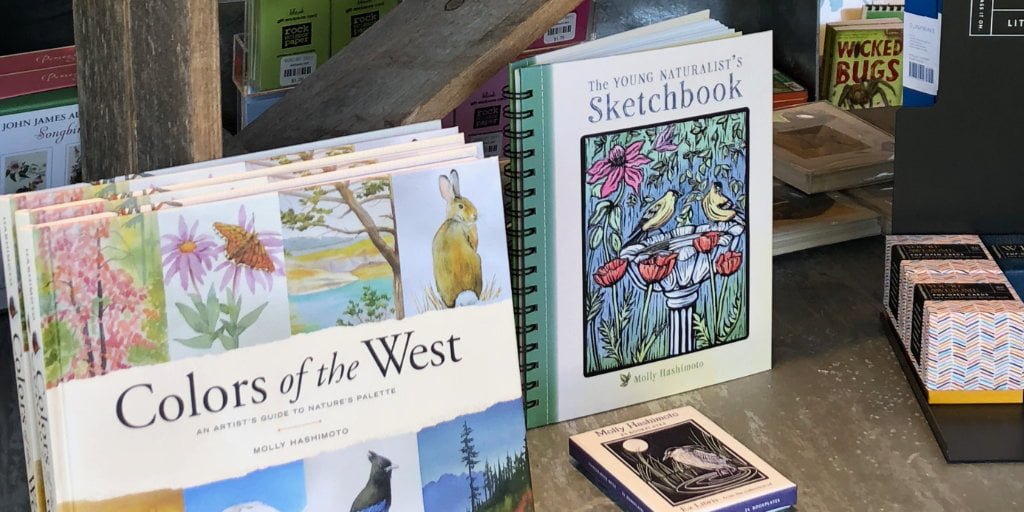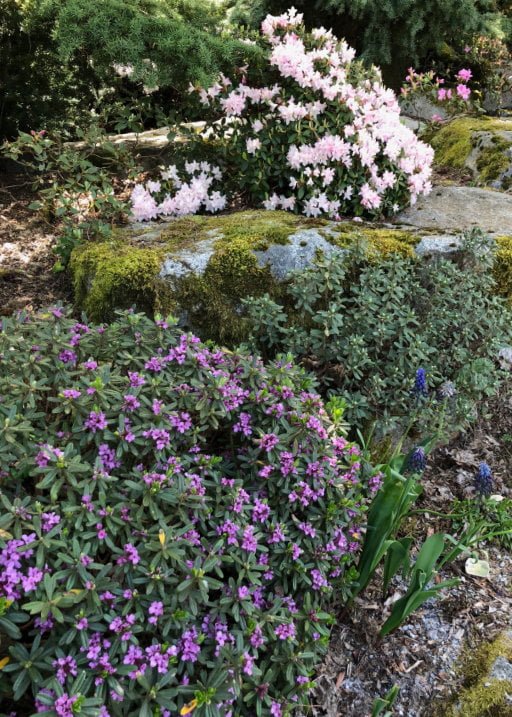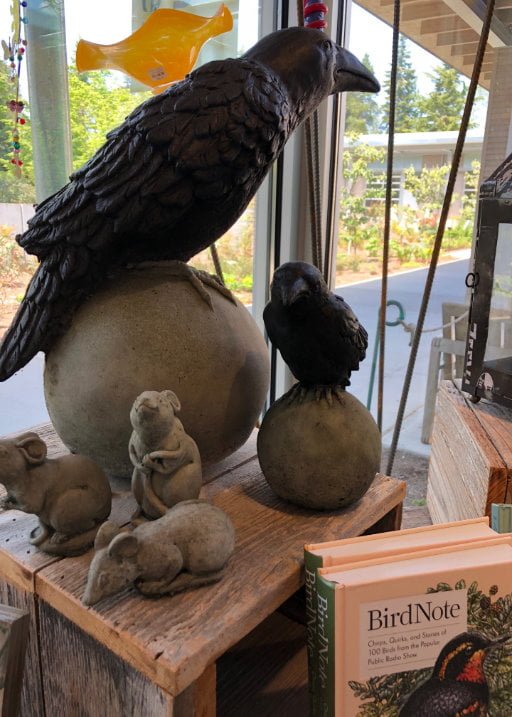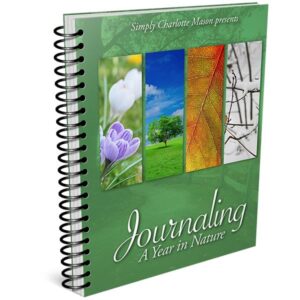Free shipping on USA orders over $129!
On a recent conference trip to the Seattle, Washington, area, we had a couple of free hours on Thursday morning before we had to set up our booth. The weather was beautiful that day: high 70s and sunny. (We found out that those days are rare; and it was a good thing we took advantage of it, because it was rainy and chilly the rest of the weekend.)
My husband John did a quick Internet search for any parks or green spaces around us where we could go walk around and enjoy the sunshine. And he found a gem: the Bellevue Botanical Garden. It was only 15 minutes from our hotel and has free admission. We spent a delightful time strolling the paths, looking at the colorful rhododendrons, vibrant Jack Frost, and soothing water features.
(Now, to be perfectly honest, I wasn’t sure whether the blooming bushes were rhododendrons or azaleas. They are cousins after all. So when we got home, I asked the master gardener at our local botanical garden just to make sure. She confirmed that the flowers with the bigger name have bigger blossoms and bigger leaves: rhododendrons. Azaleas are in the same family but have smaller blooms and smaller leaves. Just thought I would throw that in for any of you who are trying to tell the difference around this time of year too. But back to the garden in Washington.)
At the end of our visit, of course I had to stop by their Trillium Store, and I was pleased to discover several nature books that look like good possibilities for my next wish list. It’s a sweet little shop, operating as a nonprofit arm of the garden. Those of you in the Bellevue area should go have a firsthand look at the lovely, non-twaddly nature books that they feature.
Keep in mind that I haven’t read these books; I’ve only leafed through them. If you want to know how I go about locating new good books, this is how it often starts. As I looked around the shop, these books caught my eye and looked like potential good finds. They’re the ones that elicited a mental “Ooo!” from me when I read the titles and scanned the covers to get an idea of what might be inside.
The next step is usually a quick look-through, trying to get the overall impression of writing style and artwork, reading a paragraph here and there and seeing if the book still holds my interest and offers the promise of living ideas. Some books end up being “fact dumps”; those I quickly close and put back on the shelf. Some have stilted, twaddly sentences or vulgar artwork; those too get put back. But some draw me in, touching my emotions and firing my imagination, inspiring immediate relations with other books and experiences already in my mind and heart. Those are the books that bring a smile to my face and a decision to try to spend more time inside their pages to make sure they live up to their promising first impression.
That’s where I am with the following titles. They gave a good first impression, but I haven’t yet read them all the way through to confirm their worth. So I can’t recommend them unequivocally. I’m simply walking you through the process and inviting you to take the next step and do your own research if one particularly grabs your interest.
If any of you are familiar with one of these titles, leave a comment and give us the inside scoop. Some of them look like they might become new friends.
The Young Naturalist’s Sketchbook by Molly Hashimoto is a small but sturdy volume that features colored woodcut images of various animals with a few notes of the author’s observations of each. The other pages provide spaces for the young naturalist to add his or her own drawings or sketches and observations. The description encourages the young naturalist with these ideas: “Maybe you can spot some of the same animals that artist Molly Hashimoto has illustrated, or maybe you’ll find others that are native to your part of the world. If you don’t know exactly what an animal is called, try to capture as many details as you can about it. Colors, unique markings, size, sounds, location, and time of day are all interesting details to record in your sketchbook. Then when you get home you can conduct research to find the creature’s common name and scientific name.”
Colors of the West: An Artist’s Guide to Nature’s Palette is also by Molly Hashimoto but designed for a different audience. I thought this one looked interesting for those who live in the western United States and like to mix accurate watercolors for their nature journals. As I leafed through the pages, the shades of greens and blues and browns in the paintings reminded me of the colors I had just seen in the botanical garden. It struck me how the hues were different from the nature in Georgia, where I live. I had never thought before about the fact that even the “same” nature colors—greens and browns, for instance—can vary around the world according to region. Perhaps this book will help some westerners find just that right shade for their nature journal entries.
The Landscapes of Anne of Green Gables: The Enchanting Island that Inspired L. M. Montgomery by Catherine Reid is filled with photographs of nature and landscapes from Prince Edward Island and includes some of the spots that Anne Shirley gave fanciful names, such as the Lake of Shining Waters. It’s fun to see the actual places that I only saw in my imagination when reading Anne of Green Gables. (Don’t ask how many times!) A book like this might encourage a kindred spirit/book lover to become a nature lover as well.
BirdNote: Chirps, Quirks, and Stories of 100 Birds from the Popular Public Radio Show edited by Ellen Blackstone. The conversational stories in this collection are short, and each one illuminates the life, habits, or songs of a particular bird. I had not heard of this radio show before, but if it is consistently like the sample stories I skimmed in the book, it could make an enjoyable resource for families who are especially interested in nature studies on birds.
Of all the books I picked up, The Birding Life: A Passion for Birds at Home and Afield by Laurence Sheehan read the most like a true living book. It shares stories and photographs of people who love to look for and learn about birds in nature. As you read their stories, you pick up ideas and tips for your own birding adventures. And you can’t help but be inspired by their love for birds. If you have a birding enthusiast in your home, or would like to encourage more observation of birds, the living stories in this book may help kindle a growing desire for birding as well as mention some practical how-to’s along the way.
A Year in the Garden: A Guided Journal by Nina and Sonya Montenegro looks like it might be inspiring for those who tend a garden of their own, whether flower, fruit, or tree. The illustrated pages provide gentle reminders, ideas, and prompts to encourage you to dream about, research, plan, cultivate, and document your garden throughout the months of the year. It’s a specialized nature journal of sorts that could provide many hours of enjoyment for gardeners, both new and experienced.
As you can see, these books are not strictly about a once-a-week nature study. They are more about expanding on those times and encouraging a naturalist mind-set. Nature study is one way to establish a habit of time in nature, but as you grow to know nature more deeply for yourself, you will find that you can personalize your studies and experiences in nature to reflect your passions and special interests. These books are designed to give you a peek into the enthusiasm of other naturalists and motivate you to continue growing in your relationship with nature and making your own discoveries.
As Charlotte Mason put it, books by naturalists are valuable to give a person “delightful glimpses into the world of wonders he lives in, to reveal the sorts of things to be seen by curious eyes, and fill him with desire to make discoveries for himself” (Home Education, p. 64).
I hope these book ideas provide that kind of encouragement for you and your family.
Weekly Nature Study
Journaling a Year in Nature is a lovely weekly guide to the out-of-doors. The sketchbook pages and durable cover are designed to stand up to treks outside, and the spiral binding makes the book lay flat for drawing. Fifty-two nature study prompts give you ideas for an entire year of once-a-week nature study. Start forming the delightful habit of time in nature!
Podcast: Play in new window | Download









I live in Bellevue and this email wad so fun! At first I thought it was gimmicky because it was so personalized. I’m glad you had a wonderful time at the Bellevue botanical gardens. It really is a gem.